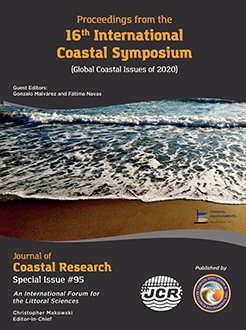Serrano, M.A.; Díez-Minguito, M.; Valle-Levinson, A., and Ortega-Sánchez, M., 2020. Circulation in a short, microtidal submarine canyon in the Alborán Sea. In: Malvárez, G. and Navas, F. (eds.), Global Coastal Issues of 2020. Journal of Coastal Research, Special Issue No. 95, pp. 1531–1535. Coconut Creek (Florida), ISSN 0749-0208.
This study analyzes the circulation of a short, microtidal submarine canyon from observations and an analytical model. The Jolúcar submarine canyon is located near the Carchuna beach (Granada, southern Spain) in the northern continental shelf of the Alborán Sea. Observations were analyzed with harmonic and spectral analyses techniques. Observations showed two layers flowing in opposite directions: down-canyon in the bottom layer and up-canyon in the upper layer. This suggest that the canyon might flush out dense materials form the nearshore. Moevoer, observed currents were mainly driven by tidal (10%) and, more significantly, by atmospheric forcing, i.e., by wind stress and local atmospheric pressure gradients, as shown by cross-spectral analysis. In order to explore the dynamics associated with these results, a classical analytical solution of wind-induced current profile in a non-homogeneous water column was extended to include the influence of pressure gradients. This result demonstrated that the circulation in Jolúcar canyon could be influenced by atmospheric pressure gradients.





